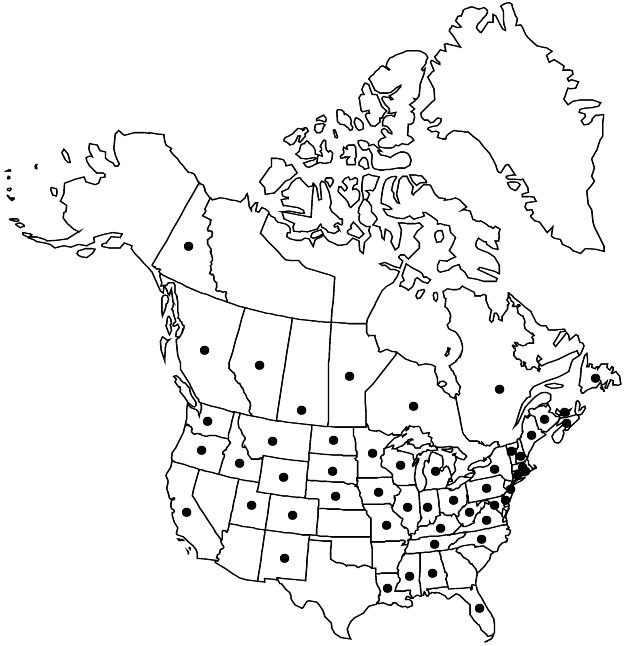Silene noctiflora
Sp. Pl. 1: 419. 1753.
Plants annual, densely pubescent throughout, viscid-glandular, especially distally; taproot slender. Stems erect, simple proximal to inflorescence or with few basal branches, branched distally, to 75 cm. Leaves 2 per node, gradually reduced distally; basal blades oblanceolate, 6–12 (–14) cm × 20–45 mm; cauline blades ascending, conspicuously veined, broadly elliptic to lanceolate, 1–11 cm × 3–40 mm, apex acute, shortly acuminate, densely pubescent on both surfaces. Inflorescences cymose, 3–15-flowered, bracteate; cyme open, flowers held on ascending branches; bracts leaflike, narrowly lanceolate, 1–5 cm, apex acuminate. Pedicels ascending, straight, 1/3–3 times longer than calyx. Flowers nocturnal, 20–25 mm diam.; calyx prominently 10-veined, ovate-elliptic, fusiform, narrowed to both ends and constricted around carpophore, 15–24 (–40) × ca. 3 mm in flower, swelling to 10 mm diam. in fruit, thin and papery, margins dentate, with pale commissures; lobes erect, often recurved in fruit, linear-lanceolate, long, narrow, (3–) 5–10 (–15) mm, apex acuminate, short-pubescent, glandular, interspersed with long eglandular hairs, veins anastomosing; corolla white, often pink tinged, clawed, claw equaling calyx lobes, limb deeply 2-lobed, lobes usually narrow, appendages 0.5–1.5 mm broad, margins entire or erose; stamens shorter than petals; styles 3, shorter than petals. Capsules ovoid, constricted at mouth, equaling or slightly longer than calyx-tube, opening by 6 recurved teeth; carpophore 1–3 mm. Seeds dark-brown to black, with gray bloom, broadly reniform, 0.8–1 mm, strongly tuberculate. 2n = 24.
Phenology: Flowering summer.
Habitat: Arable land, disturbed ground
Elevation: 0-3000 m
Distribution

Introduced; Alta., B.C., Man., N.B., Nfld. and Labr. (Nfld.), N.S., Ont., P.E.I., Que., Sask., Yukon, Alaska, Ala., Calif., Colo., Conn., Del., D.C., Fla., Idaho, Ill., Ind., Iowa, Ky., La., Maine, Mass., Mich., Minn., Miss., Mo., Mont., Nebr., N.H., N.J., N.Mex., N.Y., N.C., N.Dak., Ohio, Oreg., Pa., R.I., S.Dak., Tenn., Utah., Vt., Va., Wash., W.Va., Wis., Wyo., Europe
Discussion
Silene noctiflora is sometimes confused with S. latifolia, but they are very different species. Silene noctiflora differs in having perfect flowers with long, very narrow calyx teeth and an elliptic, fruiting calyx that is narrow at the mouth and constricted around the capsule base. It also has three styles and a capsule that dehisces by six teeth; S. latifolia has (four or) five styles and a capsule that dehisces by five bifid teeth. The flowers of S. noctiflora, as its name indicates, are nocturnal and moth-pollinated.
Selected References
None.
Lower Taxa
"thin" is not a number.